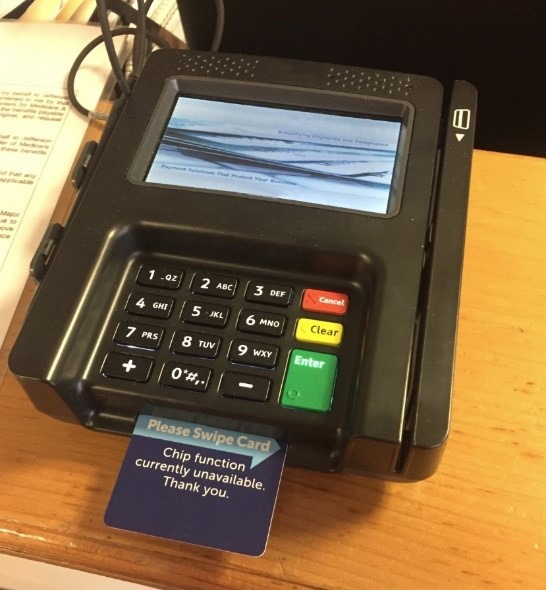At point-of-sale touchpoints (when a consumer pays in-person) in organizations across the country, consumers have gradually learned the new process of inserting their credit cards, rather than swiping. However, as consumers adjust to this new way to pay, they are frequently bombarded with a message telling them the opposite: “Chip function unavailable. Please swipe card.” They’re seeing this confusing message because, though the business purchased an EMV-enabled card device, they still cannot accept EMV transactions.
Remind Me What EMV Is Again:
EMV (short for Europay, Mastercard and Visa), a global standard for authenticating chip-based debit and credit card transactions, is very effective in preventing card-present fraud. In October 2015, the major processing banks implemented a shift that transferred fraud liability to merchants who accept fraudulent chip card transactions, unless they use EMV-capable point of sale (POS) devices. This fraud liability impacts healthcare organizations as well. After the liability shift, millions of merchants, including healthcare providers, reacted by purchasing new card reader devices that could support EMV transactions. According to Visa, there are 1.46 million chip-enabled business across the U.S.
So, Why Are Consumers Still Asked to Swipe so Often?
When consumers visit retailers, they often see a post-it note or some kind of warning over the chip card insert slot that says “Please swipe.” Why is that?

The reality is that EMV is hard. There are plenty of expensive devices available for purchase that support chip card transactions, but having an EMV-capable device is not enough to actually process EMV transactions. Your merchant processing solution needs to be able to support EMV as well. In order to do so, your vendor needs to become EMV-certified with every processor they work with, every card brand and every device they offer. Not only is the certification process difficult and time-consuming, it also costs hundreds of thousands of dollars each time a vendor goes through the process. Ultimately, a lot of roadblocks can pop up, usually as a result of handoffs between your gateway, processor and acquirer.
Does That Mean I’m Stuck Without EMV?
To a certain degree, healthcare organizations are at the mercy of their vendor’s timeline to offer EMV. However, you do have control over the choice of a full stack vendor.
What Does “Full Stack” Mean?
Full stack means a single platform that has ownership and accountability of the end-to-end healthcare payments infrastructure, from the point where you capture payment information through the funding, settlement and reconciliation.
Achieving a full stack solution on a single platform is a major investment, and can’t be achieved through mergers, acquisitions or plug-in solutions from multiple vendors.
For the latest payment innovations, like EMV and Apple Pay®, a full stack vendor is able to deliver faster and easier, because they are accountable for every piece of that transaction.
So, “Full Stack” Goes Beyond EMV?
Yes. A full stack vendor eliminates the handoffs between acquirers, gateways and processors because it manages all of these functions on a single platform. This means fewer road blocks and diversions to deliver payment innovations, like EMV, Apple Pay and beyond. Keep in mind that EMV and Apple Pay aren’t the only areas where a non-full stack vendor can fall behind. There’s more at stake.
Security Risks and Costs
When multiple vendors touch a transaction, there are more potential failure points, as handoffs between vendors significantly increase security risks. PCI scope also increases, because the more vendors involved in a payment transaction, the more scope there is that has to be assessed. The PCI compliance burden that results when relying on multiple vendors can cost healthcare organizations hundreds of thousands to even millions of dollars each year. Furthermore, reducing PCI scope becomes nearly impossible when multiple vendors are responsible for different pieces of the payment transaction.
Instability
Lack of ownership of the end-to-end payment process leads to accountability gaps when issues arise. For example, what happens with chargebacks or returns? Who has visibility into payment issues at any point in the payment process? Is it the bank? The gateway? Do you have visibility into the issue? Since a full stack vendor has full accountability for the end-to-end payment process, they have full visibility into every payment transaction, and can offer the same visibility to their healthcare providers. With non-full stack vendors, providers may find themselves making multiple phone calls trying to track down any one of the number of vendors involved at each step of a transaction.
Inefficiency
Think about all the payment channels that providers need to support in order to collect from patients: phone, online, point of service, mail, bank bill pay, etc. How many vendors do you work with to support all of these channels? Chances are, if you’re not using the same, full stack vendor, then you are wasting a lot of time reconciling payments that come through each of those different channels.
Poor Consumer Experience
Consumers are exposed to new and convenient payment capabilities in other industries, and often wish to have the same convenient experiences in healthcare as well. Every time a healthcare organization cannot deliver on a new payment channel like EMV and Apple Pay, the patient payment experience is damaged. When a consumer wants to use their preferred payment method but they’re forced to dig into their pocket and pull out their back-up option, this is a negative experience. This is significant because the consumer perspective can have a great impact beyond the individual patient relationship with a healthcare organization. According to the Hospital Consumer Assessment of Healthcare Providers and Systems (HCAHPS) patient satisfaction survey, patients are five times more likely to recommend a healthcare organization when they have a positive payment experience.
